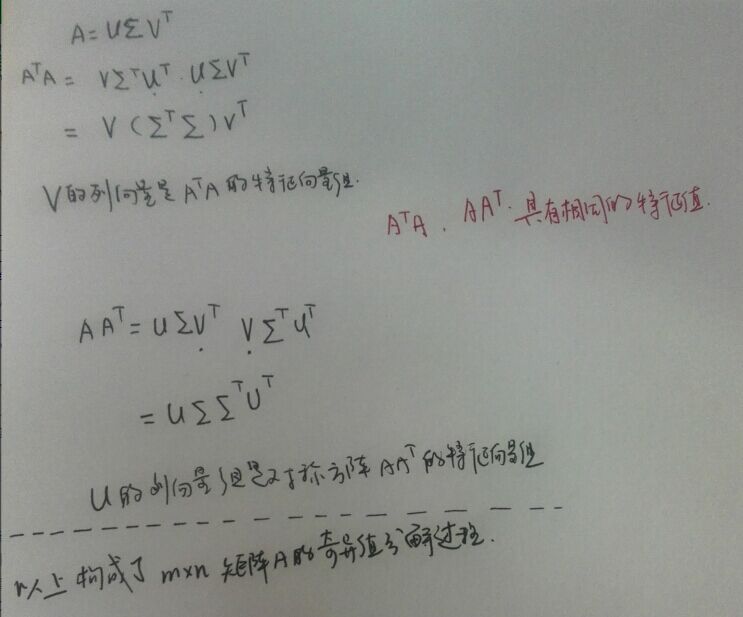定义
矩阵的奇异值分解,顾名思义,是矩阵分解的一种。定义如下:
In linear algebra, the singular value decomposition (SVD) is a factorization of a real or complex matrix. It has many useful applications in signal processing and statistics.
Formally, the singular value decomposition of an m × n real or complex matrix M is a factorization of the form M = UΣV∗, where U is an m × m real or complex unitary matrix, Σ is an m × n rectangular diagonal matrix with non-negative real numbers on the diagonal, and V∗ (the conjugate transpose of V, or simply the transpose of V if V is real) is an n × n real or complex unitary matrix. The diagonal entries Σi,i of Σ are known as the singular values of M. The m columns of U and the n columns of V are called the left-singular vectors and right-singular vectors of M, respectively.
那么奇异值分解和特征值分解是什么关系呢?
The singular value decomposition and the eigendecomposition are closely related. Namely:
The left-singular vectors of M are eigenvectors of MM∗.
The right-singular vectors of M are eigenvectors of M∗M.
The non-zero singular values of M (found on the diagonal entries of Σ) are the square roots of the non-zero eigenvalues of both M∗M and MM∗.
思路总结如下:

尤其需要注意外积形式的SVD
A=u1*c1*v1'+u2*c2*v2'+……+uk*ck*vk'
应用前景
在机器学习领域,有相当多的应用与奇异值都可以扯上关系,比如做feature reduction的PCA,做数据压缩(以图像压缩为代表)的算法,还有做搜索引擎语义层次检索的LSI(Latent Semantic Indexing)
调用代码
在matlab中可以直接调用svd()函数即可。
>> A=[1 2;3 4; 5 6;7 8]
A =
1 2
3 4
5 6
7 8
>> size(A)
ans =
4 2
>> svd(A)
ans =
14.2691
0.6268
>> [U,S,V]=svd(A)
U =
-0.1525 -0.8226 -0.3945 -0.3800
-0.3499 -0.4214 0.2428 0.8007
-0.5474 -0.0201 0.6979 -0.4614
-0.7448 0.3812 -0.5462 0.0407
S =
14.2691 0
0 0.6268
0 0
0 0
V =
-0.6414 0.7672
-0.7672 -0.6414
图像处理
svd可以运用到许多的领域,如搜索引擎算法,图像处理,人脸识别,等等。下面以图像处理为例,进行说明。
>> A=imread('56039.JPG');
>> I = mat2gray(A);
>> M=I(:,:,1);
>> [U,S,V]=svd(M);
>> M_100=U(:,1:100)*S(1:100,1:100)*V(:,1:100)';
>> imshow(M_100)
>> M_200=U(:,1:200)*S(1:200,1:200)*V(:,1:200)';
>> imshow(M_200)
>> M_300=U(:,1:300)*S(1:300,1:300)*V(:,1:300)';
>> imshow(M_300)
>> M_10=U(:,1:10)*S(1:10,1:10)*V(:,1:10)';
>> imshow(M_10)
>> ttr1svd(I);
>> imshow(U)
>> imshow(S)
>> imshow(V)
Warning: Image is too big to fit on screen; displaying at 67%
> In imuitools\private\initSize at 72
In imshow at 283
>> BB=U*S*V';
>> imshow(BB)
We can represent images as matrices. Consider an image having n times m pixels. For gray scale images, we need one number per pixel, which can be represented as a n times m matrix. For color images, we need three numbers per pixel, for each color: red, green and blue (RGB). Each color can be represented as a n times m matrix, and we can represent the full color image as a n times 3m matrix, where we stack each color’s matrix column-wise alongside of each other, as A=[A_{rm red},A_{rm green},A_{rm blue}].Using the low-rank approximation via SVD method, we can form the best rank-k approximations for the matrix.





















 387
387











 被折叠的 条评论
为什么被折叠?
被折叠的 条评论
为什么被折叠?








